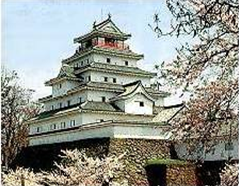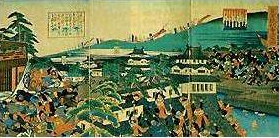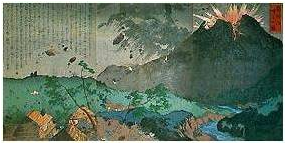JET in Fukushima: History
      |
JET in Fukushima
History of Fukushima
Introduction of Buddhist Culture In the 6th century, Buddhism was introduced into Japan from the Asian mainland. At first, this religion was followed mainly by influencial nobles in the capital. Later, it won the patronage of the Imperial family itself, which helped spread the religion nationwide while encouraging the construction of Buddhist temples throughout Japan. The area of what is now called Fukushima Prefecture came under the influence of the Yamato Court ahead of the rest of Michinoku; Buddhism is said to have been transmitted to the area in the 7th century. During the golden age of Buddhist culture, from the 9th to l2th centuries, the Fukushima area flourished as one of the centers of Buddhist culture in northeastern Japan. Many important temples, such as E'nichi-ji Temple in Aizu and Shiramizu Amidado Pavilion in Iwaki, date from this era. Tsurugajo Castle and the Rise of the Aizu Clan In the 14th century, the Ashina clan erected Kurokawa Castle in Aizu. During the Warring States Period (1467-1568), when the central military government collapsed, the Date clan based in the Fukushima Basin and the Ashina clan based in the Aizu Basin emerged as strong powers in northeastern Japan. Lord Masamune Date, full of ambition to reunite the country, defeated the Ashina clan in battle and took Kurokawa Castle in 1589. However, when the nation was reunified the following year by Hideyoshi Toyotomi, a more powerful warrior leader based in southwestern Japan, the Date clan was removed from its fief in Aizu, and Kurokawa Castle was occupied by Ujisato Gamo, a Hideyoshi retainer. At about this time, the castle came to be called Tsurugajo Castle. Hideyoshi's eventual successor, Ieyasu Tokugawa established the Tokugawa Shogunate in 1603. The shogunate, ruling the country from Edo (now Tokyo), placed two Tokugawa related clans, the Aizu and Shirakawa, in the Fukushima area, from where they were to oversee northern Japan. The Aizu clan's founder was Masayuki Hoshina, a younger half brother of the third Tokugawa shogun. Thence, throughout the centuries of the Edo Period (1643-1871) , the nine generations of the Aizu clan were firm supporters of the Tokugawa Shogunate.
Fukushima Prefecture's Place in Japan's Modernization As Japan industrialized during the Meiji Period, Fukushima Prefecture flourished. After the Tokyo-Sendai section of the Tohoku Honsen railway line opened in 1887, the Date area of Fukushima Prefecture, which had thrived as a major center of sericulture since the late Edo Period, used the railway to transport large amounts of raw silk to coastal areas, from where they were exported. Construction of the Joban railway line was begun in 1894, and in 1898 the Mito-Iwanuma section of the line was opened, spurring industrial activity in the Hamadori district. In particular, the Joban coalfield in Iwaki City, in operation since the late Edo Period, greatly enhanced its productivity with the introduction of highly efficient modern equipment; at its peak, the coalfield supplied most of the coal consumed by the Tokyo area. The pace of prefectural development was so rapid that in 1899 the Bank of Japan selected the prefecture as the location for its first branch in the Tohoku region. The building of hydroelectric power stations was also energetically pursued to help meet the increasing energy requirements of industrial development. One example, the Tagokura Power Station, Japan's largest reservoir-type power station, was constructed in 1959 in Tadami Town, an area blessed with rich water resources. The power station has served as a vital component of the industrial infrastructure up to the present, helping speed the prefecture's economic recovery after World War II, and the region remains a major center of hydroelectric power generation. The mid-20th century saw the start of construction of nuclear power stations in the central part of the Hamadori region.Up until the accident at the Nuclear Power Plant, nuclear power generation was the foremost energy source, however now the prefecture is focusing on the introduction of renewable energy including solar, and wind generated power, with projects such as the Minami Soma Solar Agri-park, and the Fukushima Floating Offshore Wind Farm Demonstration Project. Contact: kokusai@pref.fukushima.lg.jp |



